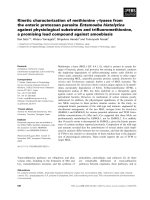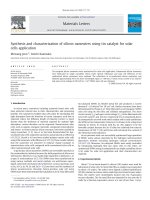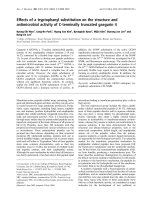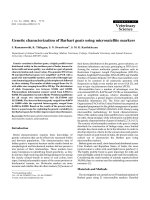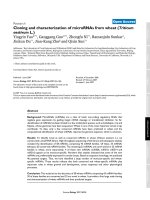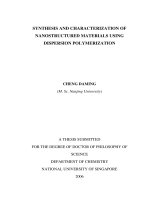Synthesis and characterization of ZnO phytonanocomposite using Strychnos nux-vomica L. (Loganiaceae) and antimicrobial activity against multidrug-resistant bacterial strains from diabetic
Bạn đang xem bản rút gọn của tài liệu. Xem và tải ngay bản đầy đủ của tài liệu tại đây (2.5 MB, 9 trang )
Journal of Advanced Research 9 (2018) 69–77
Contents lists available at ScienceDirect
Journal of Advanced Research
journal homepage: www.elsevier.com/locate/jare
Original Article
Synthesis and characterization of ZnO phytonanocomposite using
Strychnos nux-vomica L. (Loganiaceae) and antimicrobial activity against
multidrug-resistant bacterial strains from diabetic foot ulcer
Katherin Steffy a,⇑, G. Shanthi a, Anson S. Maroky b, S. Selvakumar c
a
b
c
Division of Microbiology, Rajah Muthiah Medical College, Annamalai University, Chidambaram 608002, Tamil Nadu, India
Department of Pharmacy, Faculty of Engineering and Technology, Annamalai University, Chidambaram 608002, Tamil Nadu, India
Department of Zoology, Faculty of Science, Annamalai University, Chidambaram 608002, Tamil Nadu, India
g r a p h i c a l a b s t r a c t
S. nux-vomica leaf
ZnO Phytonanocomposite
S. nux-vomica leaf extract
a r t i c l e
i n f o
Article history:
Received 18 June 2017
Revised 25 October 2017
Accepted 2 November 2017
Available online 3 November 2017
Keywords:
ZnO phytonanocomposite
Strychnos nux-vomica
Multidrug resistance (MDR)
Antibacterial activity
Zn2+
Zn2+
Zn2+
Zn 2+ Zn2+2+
AnƟbacterial
Zn2+ 2+ Zn Zn2+Zn
acƟvity
Zn
2+ Zn
2+Zn
Zn2+Zn
a b s t r a c t
Nanobiotechnology has been emerged as an efficient technology for the development of antimicrobial
nanoparticles through an eco-friendly approach. In this study, green synthesized phytonanocomposite
of ZnO from Strychnos nux-vomica leaf aqueous extract was characterized by X-ray diffraction analysis
(XRD), UV–visible-spectroscopy, Photoluminescence spectroscopy (PL), Fourier transform infrared spectroscopy (FTIR), X-ray photoelectron spectroscopy (XPS), High-resolution Transmission Electron
Microscopy (HR-TEM), and Energy dispersive X-ray analysis (EDX). Antibacterial activity was investigated against multidrug-resistant bacteria (MDR) isolated from diabetic foot ulcers (DFUs), such as
MDR–methicillin resistant Staphylococcus aureus (MRSA), MDR–Escherichia coli, MDR–Pseudomonas
aeruginosa, MDR–Acinetobacter baumannii, as well as against standard bacterial strains, S. aureus ATCC
29213, E. coli ATCC 25922, P. aeruginosa ATCC 27853, and E. faecalis ATCC 29212 through disc diffusion
assays on Muller Hinton Agar. The characterization studies revealed a size-controlled synthesis of
quasi-spherical hexagonal wurtzite structured ZnO phytonanocomposite with an average size of 15.52
nm. Additionally, remarkable bactericidal activities against MDR clinical as well as ATCC bacterial strains
were exhibited, with a maximum zone of inhibition of 22.33 ± 1.53 mm (against S. aureus ATCC 29213)
and 22.33 ± 1.16 mm (MDR–MRSA) at a concentration of 400 mg/mL. This study thus established the
Peer review under responsibility of Cairo University.
⇑ Corresponding author.
E-mail addresses: (K. Steffy), (G. Shanthi), (A.S. Maroky),
(S. Selvakumar).
/>2090-1232/Ó 2017 Production and hosting by Elsevier B.V. on behalf of Cairo University.
This is an open access article under the CC BY-NC-ND license ( />
70
K. Steffy et al. / Journal of Advanced Research 9 (2018) 69–77
possibility of developing antimicrobial ZnO nanocomposite of Strychnos nux-vomica leaf extract to combat developing drug resistance currently being experienced in health care facilities.
Ó 2017 Production and hosting by Elsevier B.V. on behalf of Cairo University. This is an open access article
under the CC BY-NC-ND license ( />
Introduction
Nanotechnology is a rapidly growing branch in the field of
Science and Engineering that uses the design of novel state-ofthe-art tools in both diagnostics and therapeutics due to inimitable
properties of nanomaterials. Among inorganic metals, the unique
physicochemical properties of ZnO make it a feasible and exceptionally attractive compound applicable for a variety of nanotechnology applications [1]. The synthesis of variable ZnO
nanostructures can be carried out meticulously with great control
due to the following features: (i) photonic and piezoelectric properties, (ii) stable polar surface and inimitable chemical qualities of
simple crystal-growth technology [2,3], (iii) IEP range within 1.7–
3.5 [4], and (iv) high excitonic binding energy of 60 meV [5]. ZnO
nanostructures also exhibit significant antibacterial and antifungal
properties [6]. Selective toxicity of ZnO nanoparticles against
microorganisms makes it an effective antimicrobial agent [7].
Conventional physical and chemical routes of synthesis of ZnO
nanoparticles are expensive; require more labour, and huge space.
Great amount of energy generated during the synthesis, raises the
environmental temperature around the source material and disposal of large quantities of secondary waste is potentially toxic
to all living beings [8]. Whereas biological route of synthesis of
nanocomposite with aid of plants is a cost-effective eco-friendly
method, with minimal expenditure and no adverse effects. Various
phytochemical constituents present in a plant such as flavonoids,
phenolics, terpenoids, polysaccharides, aldehydes, amines and proteins, act as reducing and stabilizing agents in the synthesis of
nanoparticles [9]. Strychnos nux-vomica is an evergreen tree
belonging to family Loganiaceae, mostly seen in an open habitat,
native to Southeast Asia and India. It is cultivated commercially
in different parts of the world such as United States, European
Union, and throughout tropical Asia. It is a central nervous system
stimulant; used for treatment of constipation and other stomach
disorders, at a low-dose level. The plant is rich in bioactive chemicals, including alkaloids (such as strychnine and brucine) [10], flavonoids, tannins, saponins, and glycoside that aid in acting as (i)
anti-inflammatory, (ii) anti-allergic, (iii) antioxidant, (iv) antidiabetic, (v) antiviral, (vi) anti-cancer, (vii) analgesic, (viii) antispasmodic, and (ix) antibacterial agents [11].
Antimicrobial resistance remains a crucial issue to be considered in the efforts for organizing and resolving the treatment of
non-healing infections, such as DFU [12]. Multidrug resistance
has been reported in Gram-negative and Gram-positive bacteria
such as Pseudomonas aeruginosa, Acinetobacter sps, Enterobacteriaceae sps, and Staphylococcus aureus due to diverse resistance
mechanisms. These mechanisms include enzymatic degradation
of antibiotics, reduced permeability, efflux pump mechanisms,
and modification of bacterial proteins (the target for antibacterial)
[13,14]. This necessitates the significance of alternative treatment
strategies with much more efficiency than conventional antimicrobial agents to prevent plausible risk with dire financial consequences
and
life-threatening
outcomes
[15].
A
few
epidemiological studies have noted temporal changes in the frequency of resistance to a specific drug, when the amount of drug
consumed in the community is deliberately reduced [16]. WHO
has recently released the list of antibiotic-resistant ‘‘priority
pathogens” of 12 bacterial families and has pointed out for the
urgent need of the development of new antimicrobial agents
[17]. Thence, the present study has investigated the green
synthesis and characterization of ZnO nanocomposite of Strychnos
nux-vomica L (Loganiaceae) leaf aqueous extract and evaluated the
antimicrobial potency against MDR clinical and ATCC bacterial
strains.
Material and methods
Materials
S. nux-vomica leaves were collected from forest areas of Western Ghats, South India, in June 2016. The plants were identified
and authenticated by the Botanical Survey of India (Southern Circle), Coimbatore (BSC/SRC/5/23/2016/Tech/1197). The Zinc nitrate
hexahydrate crystals [Zn (NO3)2Á6H2O] of EMPLURAÒ grade was
purchased from Merck (Darmstadt, Germany). The chemicals and
glassware were procured from Sigma-Aldrich (St Louis, MO, USA)
and Himedia (Mumbai, India). Multidrug-resistant clinical bacteria
such as MRSA, P. aeruginosa, A. baumannii, and E. coli were isolated
from the pus samples of DFU patients admitted at Rajah Muthiah
Medical College and Hospital (RMMCH), India with the approval
of Institutional Human Ethical Committee (M18/RMMC/2015).
The patient samples were collected after obtaining informed consents from them. Preliminary identification and antibiotic susceptibility pattern of clinical isolates were processed at the Division of
Microbiology, RMMCH. The results were further confirmed with
VITEK 2Ò Compact automated system using GN Test Kit VTK2/GP
Test Kit VTK2 (bio Mérieux, Marcy l’Etoile, France). The standard
bacterial strains, S. aureus ATCC 29213, P. aeruginosa ATCC 27853,
E. faecalis ATCC 29212, and E. coli ATCC 25922, were obtained from
CSIR-National Chemical Laboratory, Pune, India.
Preparation of S. nux-vomica leaf aqueous extract
The leaves were washed thoroughly with double-distilled water
and were allowed to dry at room temperature. Dried leaves were
tattered and ground in a blender to a coarse powder. Plant powder
(20 g) was heated with 100 mL of double-distilled water for 20 min
at 60 °C. The light yellow coloured solution formed during boiling
was allowed to cool to room temperature. In order to obtain a clear
extract, the mixture was filtered through Whatman No.1 filter
paper, centrifuged and stored in the refrigerator until further use.
Biosynthesis of S. nux-vomica–ZnO nanocomposite
Different concentrations of S. nux-vomica leaf aqueous extract
(20, 30, and 40 mL) were added with 2 g of Zinc nitrate hexahydrate crystals and were allowed to dissolve using a magnetic stirrer. After complete dissolution of the mixture, the solution was
vigorously stirred at 100 °C for 2 h until the colour changed from
light yellow to deep yellow. After cooling at room temperature,
the mixture was centrifuged at 5000 rpm for 10 min, and a solid
precipitate was obtained. The solid product was centrifuged twice
at 5000 rpm for 10 min after thorough washing and heated at 60–
80 °C until the formation of deep yellow coloured paste. Annealing
was carried out in a muffle furnace at 400 °C for 2 h. The light yellow coloured material obtained was ground using a mortar to a
fine powder, which was used for further characterization and
antibacterial assays.
K. Steffy et al. / Journal of Advanced Research 9 (2018) 69–77
Characterization studies of S. nux-vomica–ZnO nanocomposite
The XRD analysis (PANalytical Empyrean Alpha 1, Netherlands)
was carried out using Cu Ka radiation (1.5406 Å) of a 2h range of
20–80°; operating at 45 kV with a current of 30 mA to identify
the structural information and crystalline phase. The average crystallite size was calculated using the Scherrer equation. Optical
properties were analysed using UV–visible absorption spectroscopy (Varian Cary 5000, Palo Alto, California, USA). PL spectra
of the samples were recorded using a fluorescence spectrometer
(PerkinElmer LS55, Shelton, USA). Functional groups were identified using FTIR Spectrometer (Perkin Elmer-Spectrum Rx1, Shelton,
USA) under identical conditions in the 400–4000 cmÀ1 region. The
surface composition was analysed by XPS (AXIS-ULTRA, Kratos
Analytical Ltd, UK). The morphology and size distribution of ZnO
nanocomposite were characterized using HR-TEM with EDX
(Jeol/JEM 2100, Tokyo, Japan) to confirm the presence of elemental
zinc and oxygen. The data were analysed using Origin Pro 7.5 SRO
software (OrginLab Corporation, USA).
Antibacterial assessment of S. nux-vomica–ZnO nanocomposite
The antibacterial activity of phytonanocomposite of ZnO was
performed by the disc diffusion method [18] on Mueller-Hinton
agar (MHA) as per the CLSI guidelines [19]. Whatman No.: 1 filter
paper discs of 6-mm diameter were allowed to infuse with 200 and
400 mg/mL of ZnO phytonanocomposite dispersed in 20% dimethyl
sulfoxide (DMSO) and kept at room temperature pending use. Bacterial suspensions were prepared in sterile saline (0.9% NaCl) by
suspending overnight grown cultures on Columbia-based blood
agar. The turbidity of bacterial suspension was adjusted to 0.5
McFarland standard and was evenly spread on MHA with a sterile
cotton swab. Discs impregnated with ZnO phytonanocomposite, S.
nux-vomica leaf aqueous extract, and bare ZnO nanoparticles were
placed on inoculated MHA plates incubated at 37 °C. Control
antibiotics, vancomycin (30 mg/mL) and colistin (10 mg/mL) were
used as positive control for Gram-positive and negative bacteria,
respectively, and the disc infused in 20% DMSO was used as a negative control. The plates were incubated at 37 °C for 24 h, the zone
of inhibition of each well was measured, and the values were
noted.
Statistical analysis
All the experiments were performed in triplicates, with the
results being expressed as Mean ± Standard Deviation (SD) of three
independent experiments. The means were statistically compared
using One-way ANOVA followed by post hoc Dunnett’s Multiple
Comparison’s tests using GraphPad Prism version 5. P < .05 was
considered as statistically significant.
Results and discussion
XRD analysis of S. nux-vomica–ZnO nanocomposite
The XRD technique exploits the scattered intensity of an X-ray
beam on the sample, thus providing information about the structural properties, physical, and chemical composition of the material studied. XRD pattern of ZnO phytonanocomposite
synthesized from 20, 30, and 40 mL of S. nux-vomica leaf extract
showed (Fig. 1) Bragg peaks corresponding well to (1 0 0), (0 0 2),
(1 0 1), (1 0 2), (1 1 0), (1 0 3), (1 1 2), (2 0 1) and (2 0 2) hkl lattice
planes of the hexagonal wurtzite structure (JCPDS Card no. 0361451). Sharp and intense diffraction peaks indicated a high crystalline nature with a large particle size of bare ZnO nanoparticles
71
[20]. However, in the case of ZnO phytonanocomposite, from different leaf extract volumes (20, 30, and 40 mL) exhibited an
ascending pattern of broad and low-intensity diffraction peaks,
indicating a reduced crystallite size with a faulting in its nanostructure [21]. Mean crystallite size was also calculated from XRD
peaks using Debye–Scherrer formula, D = 0.9k/b Cosh, where D is
the average crystallite size, k is the wavelength of X-ray, b is full
width at half maximum in radians (FWHM), and h is the Diffraction
angle in radians. The obtained average particle size of ZnO phytonanocomposite was 31.18, 25.01, and 15.52 nm from 20, 30, and
40 mL of plant extract, respectively, and 69.85 nm for bare ZnO
nanoparticles. XRD pattern of nanoparticles gave valuable structural information along with Debye–Scherrer calculation [22].
The above results clearly indicate that the optimal addition of plant
extracts greatly influences the synthesis of ZnO nanocrystals with a
reducing particle size. Various phytochemicals such as alkaloids,
steroids, flavonoids, carbohydrates, glycosides, terpenoids, saponins, and proteins are acting as reducing and capping agents for
the green synthesis of nanoparticles. This is in agreement with previous studies [23]. The concentration of leaf extract is effectively
involved in controlling particle size when compared to bare ZnO
nanoparticles.
Optical properties of S. nux-vomica–ZnO nanocomposite
UV–vis spectroscopy is a technique that is used to characterize
optical properties of nanoparticles. The absorbance of ZnO phytonanocomposite synthesized from S. nux-vomica plant extract of
20, 30, and 40 mL shifted to smaller wavelengths of 351 nm, 341
nm, and 335 nm (Fig. 2a), respectively; the finding which is in line
earlier report [24]. The absorbance of bare ZnO nanoparticles was
approximately 353 nm (Fig. 2b). The wavelength of absorption
spectrum below 358 nm, indicated a strong blue shift in absorption
spectra due to reduced particle size, lesser than bulk excitation of
the Bohr radius, in accordance to the previous literature [25]. The
direct band gap energy of green biosynthesized ZnO phytonanocomposite was calculated by Wood-Tauc’s relation [26]. It
was estimated to be 3.53 eV, 3.64 eV, and 3.7 eV, corresponding
to 351, 341, and 335 nm, respectively. Increased band gap (Eg) is
the effect of quantum confinement on nano regime. Moreover,
direct optical band gap energy (eV) is inversely proportional to
the particle size of nanoparticles [27]. On the basis of XRD data
and UV–visible-absorption spectrum, ZnO phytonanocomposite
from 40 mL plant extract exhibited least particle size and high
band gap energy (15.52 nm, 3.7 eV) than that of 30 mL (25.01
nm, 3.64 eV), and 20 mL (31.18 nm, 3.53 eV) of S. nux-vomica plant
extract. Since the previous study [28] has pointed out the enhanced
biological effects of nanoparticles with reduced crystallite size,
ZnO phytonanocomposite prepared from 40 mL of S. nux-vomica
plant extract was analysed for further studies.
PL provides valuable information regarding the purity and quality of the crystallite structures. PL spectra of ZnO phytonanocomposite synthesized from 40 mL of S. nux-vomica plant extract
exhibited the emission peaks at 421.5, 443, 458.5, 482, and
528.5 nm (Fig. 3a). All the PL emission bands were in the visible
light range, i.e., the deep level emission can be attributed to the
structural defects of ZnO nanoparticles [29]. Emission peaks
421.5 and 443 nm in the range of violet–blue spectrum, indicated
the presence of interstitial zinc (Zni). Blue–green emission at
458.5 and 482 nm can be ascribed to zinc vacancies (VZn). Green
emission at 528.5 nm indicated singly ionized oxygen vacancies
(VO) [30]. Thus, high-intensity PL emission bands in the range of
the defect-oriented visible spectrum occurred due to faster and
effective trapping of the photogenerated holes at the surface site,
because of the high number of singly ionized oxygen vacancies
and zinc vacancies. This indicates the presence of structural defects
72
K. Steffy et al. / Journal of Advanced Research 9 (2018) 69–77
Fig. 1. XRD pattern of biosynthesized S. nux-vomica–ZnO nanocomposite.
Fig. 2. UV–visible absorbance spectra of (a) biosynthesized S. nux-vomica–ZnO nanocomposite (b) bare ZnO nanoparticles at room temperature.
in ZnO nanocrystals, which may be responsible for its biological
features [31]. Fig. 3b shows PL spectra for bare ZnO nanoparticles
with low intense three emission bands (411, 461, and 480 nm) corresponding to broad deep-level (BDL) visible emissions, indicating
zinc interstitial vacancies with low crystalline features.
FTIR analysis of S. nux-vomica–ZnO nanocomposite
The FTIR spectral analysis was conducted to identify the possible biomolecules responsible for the synthesis of S. nux-vomica–
ZnO phytonanocomposite. FTIR spectra of S. nux-vomica plant
extract (Fig. 4a) has shown broad absorption bands at 3280.92 cmÀ1,
representing OH stretching vibrations of water, alcohols, and
phenols [25]. The weak absorption peak at 2927.94 cmÀ1
represented CAH stretching of alkanes and alkynes. The peak at
1589.34 cmÀ1 represented NAH bending vibrations of amines.
Stretching vibrations present at 1394.53 cmÀ1 represented C@O
stretching of alkanes and alkyls [24]; 1267.23 cmÀ1 were
associated with CAN stretching vibrations of aliphatic amines [9].
Stretching vibrations of 1068.56 cmÀ1 and 1026.13 cmÀ1 represented CAO stretching of alcohols and carboxylic acid groups.
The above data indicated the presence of phenols, terpenoids,
K. Steffy et al. / Journal of Advanced Research 9 (2018) 69–77
73
Fig. 3. Photoluminescence of (a) S. nux-vomica–ZnO nanocomposite in 40 mL (b) bare ZnO nanoparticles at room temperature.
Fig. 4. FTIR spectra of (a) S. nux-vomica leaf aqueous extract (b) biosynthesized S. nux-vomica–ZnO nanocomposite in 40 mL (c) bare ZnO nanoparticles.
flavonoids, amino acids, carbohydrates, tannins, and saponins in S.
nux-vomica plant extract [32]. FTIR spectra of ZnO phytonanocomposite from 40 mL of S. nux-vomica plant extract (Fig. 4b) exhibited
an IR absorption band highly shifted 3280.92–3404.36, 1589.34–
1415.75, 1267.23–1114.86, 1068.56–875.68, 586.36–619.15, and
511.14–434 cmÀ1. This indicates the participation of soluble phytochemicals such as polyols, terpenoids, and proteins having functional groups of amines, alcohols, ketones and carboxylic acids, as
reducing and stabilizing agents that aid in the formation of ZnO
phytonanocomposite, preventing aggregation of nanoparticles in
the solution [27]. The wide peak in the range of 530–420 cmÀ1 is
characterized by zinc oxide and is associated with the stretching
vibrations in Zn-O shown in the region of 434 cmÀ1 [33].
XPS analysis of S. nux-vomica–ZnO nanocomposite
The wurtzite nature and the chemical purity of the
S. nux-vomica–ZnO nanocomposite were confirmed by XPS
analysis. Wide scan of XPS spectra shown in Fig. 5a exhibited Zn
and O peaks and hence sustained the chemical purity of the surface
of S. nux-vomica–ZnO nanocomposite. Fig. 5b and c showed the
high-resolution XPS spectra of the elements Zn and O, respectively.
74
K. Steffy et al. / Journal of Advanced Research 9 (2018) 69–77
Fig. 5. XPS of biosynthesized S. nux-vomica–ZnO nanocomposite in 40 mL (a) wide range, (b) Zn, (c) O.
Two strong peaks centred at 1021.19 and 1044.15 eV corresponding to the Zn 2p3/2 and Zn 2p1/2 are clearly observed in Fig. 5b.
These values are in concurrence with the binding energies of
Zn2+ ion similar to the earlier reports [9]. The deconvolution of
the O1s, which is ascribed to the OÀ
2 ions in the wurtzite ZnO structure, demonstrated four major peaks centred at 528.13, 530.20,
531.54, and 532.56 eV (Fig. 5c). According to a previous study, they
originated from surface defects and chemisorbed oxygen, respectively [30].
hexagonal wurtzite structure (JCPDS-36-1451). This correlated
with XRD pattern of S. nux-vomica–ZnO nanocomposite in agreement with previous study [34]. EDX analysis of green synthesized
ZnO phytonanocomposite using S. nux-vomica plant extract
showed high-intensity peaks of Zn element and low-intensity
peaks of O, Cl, K, Ca, and C elements (Fig. 7), which confirmed
the presence of ZnO nanoparticles. The weak signals of other elements are due to presence of biometabolites in the plant extract,
which is capped on the surface of ZnO phytonanocomposite [29].
TEM and EDX analysis of S. nux-vomica–ZnO nanocomposite
Antibacterial assessment of S. nux-vomica–ZnO nanocomposite
The transmission electron microscopic analysis was performed
to study the morphology and size of the biosynthesized ZnO
nanocrystals. TEM images of ZnO phytonanocomposite shown in
Fig. 6a reported agglomerated quasi-spherical–shaped ZnO
nanoparticles, with average size within a range of 10–20 nm. Particle size demonstrated in histogram data with a Gaussian distribution centred at hu particlei is $11.68 nm (Fig. 6b). The Selected
Area Electron Diffraction (SAED) patterns shown in Fig. 6c is of
combined spotty ring pattern; indicating that synthesized
nanoparticles are of highly multi-crystalline nature. The HR-TEM
image at resolution of 0.5 nm (Fig. 6d) has focussed on single
ZnO phytonanocomposite, revealing its reticular plans at the distance between 0.25 nm and 0.26 nm, equivalent to d (Å) and corresponding to hkl lattice planes of (1 0 1) and (0 0 2) of zincite
The antibacterial activity of biosynthesized S. nux-vomica–ZnO
nanocomposite towards standard bacterial strains and clinical bacterial isolates from DFU tested by standard disc diffusion on MHA
are summarized in Table 1. Green synthesized ZnO phytonanocomposite exhibited significant antimicrobial activity against MDR
clinical and ATCC bacterial strains, which was evaluated by a zone
of inhibition in millimetre (mm). A maximum zone of inhibition
was exhibited by S. aureus ATCC 29213 (22.33 ± 1.53 mm) and by
MDR–MRSA (22.33 ± 1.16 mm), compared to plant extract and
bare ZnO nanoparticles. A minimum zone of inhibition was
observed against E. faecalis ATCC 29212 (about 12.33 ± 0.58 mm).
However, green synthesized ZnO phytonanocomposite had more
antibacterial potential than S. nux-vomica plant extract and bare
ZnO nanoparticles. Enhanced antibacterial activity is due to the
K. Steffy et al. / Journal of Advanced Research 9 (2018) 69–77
75
Fig. 6. TEM image of (a) annealed biosynthesized S. nux-vomica–ZnO nanocomposite in 40 mL inset picture of higher magnification, (b) gaussian distribution of particle size
corresponding to TEM images, (c) selected area electron diffraction (SAED) pattern, (d) HR-TEM image.
presence of soluble phytochemicals responsible for the medicinal
properties of S. nux-vomica leaf demonstrated through FTIR
analysis, acting as a precursor for the green synthesis of ZnO
phytonanocomposite. FTIR spectral data of S. nux-vomica–ZnO
nanocomposite also showed the presence of functional compounds
of phytochemical compounds even after annealing at 400 °C; proving the presence of plant compounds in ZnO phytonanocomposite,
thus responsible for its antimicrobial effects (Fig. 4).
Gram-positive cocci including MDR–MRSA, and S. aureus ATCC
29213 exhibited higher antibacterial potential than Gramnegative bacteria, based on the results of disc diffusion assay on
MHA. Increased susceptibility of Gram-positive bacteria over
Gram-negative bacteria could be related to differences in cell wall
structure, cell physiology, metabolism or degree of contact [35].
Lipopolysaccharide (LPS) present in the cell wall of Gramnegative bacteria may resist the bactericidal action of ZnO phytonanocomposite than Gram-positive bacteria devoid of LPS. Above
results can be correlated with similar results to the study of Qian
et al. [36] on green nano formulation of ZnO Aloe vera, which also
demonstrated higher antibacterial efficiency of Gram-positive
cocci, S. aureus (17.55 ± 0.02 to 28.12 ± 0.26 mm) than Gramnegative bacilli E. coli (15.38 ± 0.07 to 26.45 ± 0.08 mm).
Several mechanisms have been reported for the antibacterial
activity of nanoparticles. The reduced particle size of ZnO phytonanocomposite demonstrated through XRD pattern and UV–
visible-spectroscopy, resulted in remarkable increase in the surface
area favouring the generation of free excitons, leading to the production of Reactive Oxygen species (ROS) lethal to bacterial cells.
Uneven edges and surfaces of S. nux-vomica–ZnO nanocomposite
demonstrated as surface defects in PL spectroscopy on contact with
bacterial cells also cause damage to its bacterial cell membrane
[37]. ZnO nanoparticles can interact with membrane lipids and disorganize the membrane structure, which leads to loss of membrane integrity, malfunction, and finally to bacterial death [38].
76
K. Steffy et al. / Journal of Advanced Research 9 (2018) 69–77
Fig. 7. EDX spectrum of biosynthesized S. nux-vomica–ZnO nanocomposite in 40 mL.
Table 1
Mean zone of inhibition (mm)a by disc diffusionb assay.
Name
S. nux-vomica Cc
(400 mg/mL)
Bare ZnO nano
(400 mg/mL)
S. nux-vomica ZnO-nano
(200 mg/mL)
S. nux-vomica ZnO-nano
(400 mg/mL)
Controld
Antibiotice
S. aureus ATCC 29213
P. aeruginosa ATCC 27853
E. faecalis ATCC 29212
E. coli ATCC 25922
MDR–MRSA
MDR–P. aeruginosa
MDR–A. baumannii
MDR–E. coli
7.33 ± 1.53
8.00 ± 1.00
8.00 ± 0.00
7.00 ± 1.00
7.33 ± 1.53
7.00 ± 1.00
7.67 ± 0.58
7.00 ± 1.00
6.33 ± 0.58 ns
6.33 ± 0.58 ns
7.00 ± 1.00 ns
9.33 ± 0.58 ns
7.00 ± 0.00 ns
6.33 ± 0.58 ns
7.00 ± 1.00 ns
7.00 ± 1.00 ns
16.00 ± 1.00***
9.67 ± 0.58 ns
11.00 ± 1.00**
11.33 ± 0.58***
20.00 ± 1.00***
10.33 ± 0.58**
8.00 ± 1.00 ns
12.67 ± 0.58***
22.33 ± 1.53***
16.00 ± 1.00***
12.33 ± 0.58***
16.00 ± 1.00***
22.33 ± 1.16***
13.33 ± 1.53***
13.00 ± 1.00***
16.00 ± 1.00***
–
–
–
–
–
–
–
–
18.33 ± 0.58***
12.67 ± 0.58***
18.00 ± 1.00***
18.33 ± 0.58***
18.33 ± 0.58***
12.67 ± 0.58***
11.00 ± 1.00**
12.67 ± 0.58***
*
P < .05 in comparison with S. nux-vomica Crude. P < .05 was considered as statistically significant.
a
Diameter zone of inhibition (mm) including the disc diameter of 6 mm.
b
Mean ± SD of three independent experiments.
c
S. nux-vomica crude extract.
d
Negative control 20% DMSO.
e
Antibiotic positive control Vancomycin 30 mg/mL for Gram-positive and Colistin 10 mg/mL for Gram-negative bacteria.
ns
Non significant.
***
P < .001.
**
P < .01.
ZnO phytonanocomposite may also penetrate into bacterial cells at
a nanoscale level and result in the production of toxic oxygen radicals, which damage DNA, cell membranes or cell proteins, and
may finally lead to the inhibition of bacterial growth and eventually to bacterial cell death [39]. Kairyte et al. [40] has also demonstrated the antibacterial activity of ZnO nanoparticles due to
electrostatic interaction within bacterial cell wall and also by the
production of reactive oxygen species, eventually leading to the
destruction of bacteria by cell shrinkage, degeneration of the membrane and surface of bacterial cells.
Conclusions
The present study demonstrated the biosynthesis of ZnO
phytonanocomposite using S. nux-vomica leaf aqueous extract.
Soluble phytochemicals of the plant enabled the synthesis of
ZnO phytonanocomposite as reducing and stabilizing agents.
On the basis of XRD patterns and UV–visible spectroscopy, particle size can be controlled by optimal addition of plant extract
volume. Structural and surface properties of S. nux-vomica–ZnO
nanocomposite enabled remarkable bactericidal activity against
MDR bacterial isolates as well as ATCC bacterial strains demon-
strated through disc diffusion on MHA. Thus, antimicrobial
assays of biosynthesized ZnO phytonanocomposite against
tested bacterial strains proved to have significant antibacterial
activity and remarkable bactericidal properties against MDR
bacterial isolates from DFU, also enlisted as critical and high
prioritized pathogens by WHO. However, further studies are
necessitated to understand the mechanism of bactericidal activity and possible toxicity.
Conflict of interest
The authors report no conflicts of interest in this work.
Compliance with Ethics Requirements
This article does not contain any studies with human or animal
subjects.
Acknowledgement
The authors wish to acknowledge the financial support from
DST-INSPIRE fellowship received by Ms. Katherin Steffy
K. Steffy et al. / Journal of Advanced Research 9 (2018) 69–77
(IF140576) under the guidance of Dr G. Shanthi. The authors also
thank Professor and Head, Division of Microbiology, RMMC, and
Professor and Head, Department of Pharmacy, Annamalai University, for providing necessary facilities to carry out this work. The
authors cordially thank Sophisticated Analytical Instrument Facility, STIC, and CUSAT for recording HR-TEM and VIT University for
Spectroscopy analysis.
References
[1] Gomez JL, Tigli O. Zinc oxide nanostructures: from growth to application. J
Mater Sci 2013;48:612–24.
[2] Gao PX, Wang ZL. Substrate atomic-termination-induced anisotropic growth of
ZnO nanowires/nanorods by the VLS process. J Phys Chem B 2004;108:7534–7.
[3] Djuriic´ AB, Ng AMC, Chen XY. ZnO nanostructures for optoelectronics: material
properties and device applications. Prog Quantum Electron 2010;34:191–259.
[4] Carcia PF, McLean RS, Reilly MH, Crawford MK, Blanchard EN, Kattamis AZ,
et al. A comparison of zinc oxide thin-film transistors on silicon oxide and
silicon nitride gate dielectrics. J Appl Phys 2007;102:074512.
[5] Gordon RG. Criteria for choosing transparent conductors. MRS Bull
2000;25:52–7.
[6] Salem W, Leitner DR, Zingl FG, Schratter G, Prassl R, Goessler W, et al.
Antibacterial activity of silver and zinc nanoparticles against Vibrio cholerae
and enterotoxic Escherichia coli. Int J Med Microbiol 2015;305:85–95.
[7] Premanathan M, Karthikeyan K, Jeyasubramanian K, Manivannan G. Selective
toxicity of ZnO nanoparticles toward Gram-positive bacteria and cancer cells
by apoptosis through lipid peroxidation. Nanomed Nanotechnol, Biol Med
2011;7:184–92.
[8] Kruis FE, Fissan H, Rellinghaus B. Sintering and evaporation characteristics of
gas-phase synthesis of size-selected PbS nanoparticles. Mater Sci Eng B 2000;
B69:329–34.
[9] Ramesh M, Anbuvannan M, Viruthagiri G. Green synthesis of ZnO
nanoparticles using Solanum nigrum leaf extract and their antibacterial
activity. Spectrochim Acta – Part A Mol Biomol Spectrosc 2015;136:864–70.
[10] Deng X, Yin W, Li W, Yin F, Lu X, Zhang X, et al. The anti-tumor effects of
alkaloids from the seeds of Strychnos nux-vomica on HepG2 cells and its
possible mechanism. J Ethnopharmacol 2006;106:179–86.
[11] Patel DK, Patel K, Duraiswamy B, Dhanabal SP. Phytochemical analysis and
standardization of Strychnos nux-vomica extract through HPTLC techniques.
Asian Pacific J Trop Dis 2012;2:S56–60.
[12] Katiyar C, Kumar A, Bhattacharya SK, Singh RS. Ayurvedic processed seeds of
nux-vomica: neuropharmacological and chemical evaluation. Fitoterapia
2010;81:190–5.
[13] Armstrong DG, Lavery LA, Wrobel JS, Vileikyte L. Quality of life in healing
diabetic wounds: does the end justify the means? J Foot Ankle Surg
2008;47:278–82.
[14] Kumar VA, Steffy K, Chatterjee M, Sugumar M, Dinesh KR, Manoharan A, et al.
Detection of oxacillin-susceptible mecA-positive Staphylococcus aureus isolates
by use of chromogenic medium MRSA ID. J Clin Microbiol 2013;51:318–9.
[15] Hobizal KB, Wukich DK. Diabetic foot infections: current concept review.
Diabet Foot Ankle 2012;1:1–9.
[16] Johnsen PJ, Townsend JP, Bohn T, Simonsen GS, Nielsen KM. Factors affecting
the reversal of antimicrobial-drug resistance. Lancet 2009;9:357–64.
[17] WHO publishes list of bacteria for which new antibiotics are urgently needed,
(World Health Organization, 2017) < />releases/2017/bacteria antibiotics-needed/en/2017> [accessed 03.03.2017].
[18] Bauer AW, Kirby WMM, Sherris JC, Turk M. Antibiotic susceptibility testing by
standard single disk method. Am J Clin Pathol 1966;45:493–6.
[19] Clinical and Labortaory Standard Institute (CLSI), Performance standards for
antimicrobial susceptibility testing: twenty-fifth informational supplement
(M100–S25) Wayne PA; 2015.
77
[20] Azizi S, Ahmad MB, Namvar F, Mohamad R. Green biosynthesis and
characterization of zinc oxide nanoparticles using brown marine macroalga
Sargassum muticum aqueous extract. Mater Lett 2014;116:275–7.
[21] Suresh D, Shobharani RM, Nethravathi PC, Pavan Kumar MA, Nagabhushana H,
Sharma SC. Artocarpus gomezianus aided green synthesis of ZnO nanoparticles:
luminescence, photocatalytic and antioxidant properties. Spectrochim Acta –
Part A Mol Biomol Spectrosc 2015;141:128–34.
[22] Abdel-Hameed SAM, Marzouk MA, Farag MM. Effect of P2O5 and MnO2 on
crystallization of magnetic glass ceramics. J Adv Res 2014;5:543–50.
[23] Fatimah I. Green synthesis of silver nanoparticles using extract of Parkia
speciosa Hassk pods assisted by microwave irradiation. J Adv Res
2016;7:961–9.
[24] Anbuvannan M, Ramesh M, Viruthagiri G, Shanmugam N. Anisochilus carnosus
leaf extract mediated synthesis of zinc oxide nanoparticles for antibacterial
and photocatalytic activities. Mater Sci Semicond Process 2015;39:621–8.
[25] Ambika S, Sundrarajan M. Plant-extract mediated synthesis of ZnO
nanoparticles using Pongamia pinnata and their activity against pathogenic
bacteria. Adv Powder Technol 2015;26:1294–9.
[26] Steffy K, Shanthi G, Maroky AS, Selvakumar S. Enhanced antibacterial effects of
green synthesized ZnO NPs using Aristolochia indica against Multi-drug
resistant bacterial pathogens from Diabetic Foot Ulcer. J Infect Public Health
2017. doi: />[27] Bhuyan T, Mishra K, Khanuja M, Prasad R. Biosynthesis of zinc oxide
nanoparticles from Azadirachta indica for antibacterial and photocatalytic
applications. Mater Sci Semicond Process 2015;32:55–61.
[28] Yamamoto O. Influence of particle size on the antibacterial activity of zinc
oxide. Int J Inorg Mater 2001;3:643–6.
[29] Elumalai K, Velmurugan S, Ravi S, Kathiravan V, Ashokkumar S. Bio-fabrication
of zinc oxide nanoparticles using leaf extract of curry leaf (Murraya koenigii)
and its antimicrobial activities. Mater Sci Semicond Process 2015;34:365–72.
[30] Diallo A, Ngom BD, Park E, Maaza M. Green synthesis of ZnO nanoparticles by
Aspalathus linearis: structural and optical properties. J Alloy Compd
2015;646:425–30.
[31] Mo CM, Li YH, Liu YS, Zhang Y, Zhang LD. Enhancement effect of
photoluminescence in assemblies of nano-ZnO particles/silica aerogels. J
Appl Phys 1998;83:4389–91.
[32] Suresh S, Karthikeyan S, Jayamoorthy K. Effect of bulk and nano-Fe2O3
particles on peanut plant leaves studied by Fourier transform infrared spectral
studies. J Adv Res 2016;7:739–47.
[33] Nagarajan S, Kuppusamy AK. Extracellular synthesis of zinc oxide nanoparticle
using seaweeds of gulf of Mannar, India. J Nanobiotechnol 2013;11:39.
[34] Thema FT, Manikandan E, Dhlamini MS, Maaza M. Green synthesis of ZnO
nanoparticles via Agathosma betulina natural extract. Mater Lett
2015;161:124–7.
[35] Reddy KM, Feris K, Bell J, Wingett DG, Hanley C, Punnoose A. Selective toxicity
of zinc oxide nanoparticles to prokaryotic and eukaryotic systems. Appl Phys
Lett 2007;90:1–3.
[36] Qian Y, Yao J, Russel M, Chen K, Wang X. Characterization of green synthesized
nano-formulation (ZnO-A. vera) and their antibacterial activity against
pathogens. Environ Toxicol Pharmacol 2015;39:736–46.
[37] Padmavathy N, Vijayaraghavan R. Enhanced bioactivity of ZnO nanoparticles—
an antimicrobial study. Sci Technol Adv Mat 2008;9:1–7.
[38] Xiu Z, Zhang Q, Puppala HL, Colvin VL, Alvarez PJJ. Negligible particle-specific
antibacterial activity of silver nanoparticles. Nano Lett 2012;12:4271–5.
[39] Lipovsky A, Tzitrinovich Z, Friedmann H, Applerot G, Gedanken A, Lubart R.
EPR study of visible light-induced ROS generation by nanoparticles of ZnO. J
Phys Chem C 2009;113:15997–6001.
[40] Kairyte K, Kadys A, Luksiene Z. Antibacterial and antifungal activity of
photoactivated ZnO nanoparticles in suspension. J Photochem Photobiol B
Biol 2013;128:78–84.
